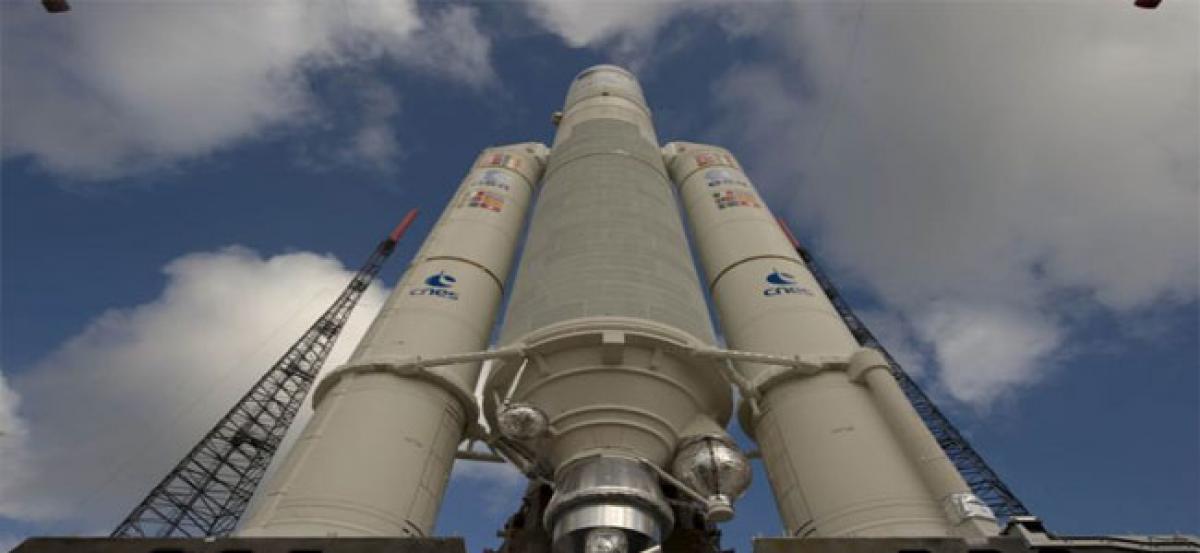Live
- Direct flights from Rajahmundry to major cities soon
- Search intensified for Gowtham Reddy as HC dismisses his bail plea
- Santosh Trophy final round to begin in Hyderabad tomorrow
- BGT: Rohit must return to opening for Brisbane Test, says Ponting
- Swimming sensation Havya steals the show
- NDTL gets WADA nod to manage Athlete Biological Passport
- BWF World Tour Finals: Treesa-Gayatri wins 2nd match to keep semis hopes alive
- Youngest ever to conquer chess world
- Jamie Lever to star in Lakshmi R Iyer’s ‘2050’: It challenged me emotionally
- Prateeksha Srivastava says she seldom meets fellow music composers Rusha, Blizza, in person
Just In

If things pan out as intended, the 5.7-tonne GSAT-11 will be most probably the last heavy Indian satellite to be launched by a foreign space agency, according to K. Sivan, Chairman of the Indian Space Research Organisation (ISRO).
CHENNAI: If things pan out as intended, the 5.7-tonne GSAT-11 will be most probably the last heavy Indian satellite to be launched by a foreign space agency, according to K. Sivan, Chairman of the Indian Space Research Organisation (ISRO).
The GSAT-11 communication satellite will be launched by Arianespace's Ariane rocket soon."We are working on a dual concept: Increasing the carrying capacity of our heaviest rocket -- the 640-tonne Geosynchronous Satellite Launch Vehicle-Mk III (GSLV Mk III) to six tonnes -- while producing high throughput and lower weight communication satellites," said Sivan.
He said nearly 60 per cent of the satellite weight consists of onboard chemical fuel and by opting for electric power for manoeuvring in space the mass of the satellite will be reduced.
The Indian space agency had tried electric propulsion in its GSAT 9 satellite.
At present, the GSLV Mk III rocket has a carrying capacity of four tonnes. The Indian space agency is working on increasing GSLV Mk III's carrying capacity to six tonnes.
"Now most of the satellites will be contained to four-six tonnes," Sivan said.
According to Sivan, the capacity enhancement is not restricted to GSLV Mk III alone but also to other rockets as it would bring down the overall launch cost.But that doesn't mean ISRO would freeze development of higher payload rockets.
"We have the capability to design and build over six-tonne payload rockets. We will start designing for bigger rockets," Sivan remarked.
"Our major objectives are to increase the production of rockets so as to increase the number of satellite launches; enhance our rocket's capability; look at reduction of rocket production cost; develop and realise the small rocket with a carrying capacity of 500 kg and also realise reusable launch vehicle/rocket," Sivan remarked.
According to him, to increase the production of rockets, the space agency is looking at transferring the technology for making Polar Satellite Launch Vehicle (PSLV) rocket to industries.
"We are working out the methodologies like joint venture for that purpose," Sivan said.
That apart, ISRO is also open for transferring the technologies developed by it to the private sector for commercialisation and wider use.
"For instance, we will be transferring the technology for making lithium ion battery that could be used to power automobiles," Sivan added.
Sivan said ISRO is also focusing on developing a reusable launch vehicle that involves a lot of new technologies and the Scramjet engine which in turn would reduce costs.
According to him, the first half of 2018 will be busy with the launch of Chandrayaan II (moon mission), GSAT 6A and a navigation satellite as the replacement for the first of the seven navigation satellites.
On January 12, ISRO launched its remote sensing satellite Cartosat.Sixty-year-old Sivan, the new head of the Indian space agency, is not shy of saying that he wore trousers and chappals for the first time when he stepped into the Madras Institute of Technology (MIT) here for a degree in aeronautical engineering."I studied in Tamil medium in a government-owned school. I wore only dhoti and shirt without any footwear till I finished my graduation at the ST Hindu College in Nagercoil.
Only after joining MIT did I start wearing trousers and chappals," Sivan told IANS.Son of a farmer, Sivan used to help his father in farming and also in his vegetables/fruits trading activity during his school days.
Today, as the head of one of the world's premier space agencies, Sivan's task is cut out.Sivan's elder son has completed electronics and communication engineering and the younger son is pursuing a graduate degree in animation while his wife is a homemaker.
Queried about his management style Sivan said: "I delegate work and expect deliverables as promised. Space system is unforgiving. If there is a problem, it will fail."

© 2024 Hyderabad Media House Limited/The Hans India. All rights reserved. Powered by hocalwire.com







